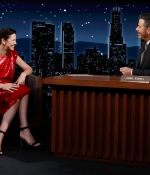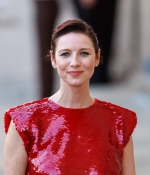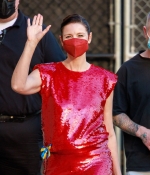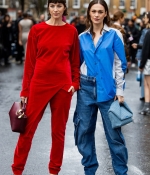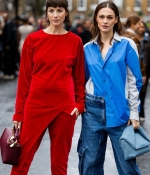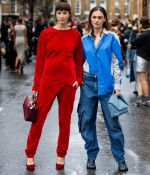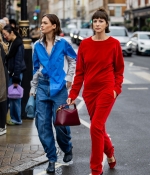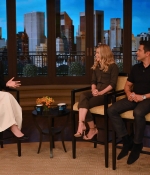

Caitriona Promotes Outlander on ‘Good Morning America’ & ‘Live! With Kelly and Ryan’
Written by admin on June 09 2023
Outlander: Claire Will Unravel in Dark and Intense Season 6
Written by admin on March 05 2022
When we last left Outlander at the end of Season 5, the men of Fraser’s Ridge had freed Claire from her abductors and rapists and Marsali had poisoned one of the men behind the attack, while Bree and Roger failed to travel back to the late 1960’s. Season 6 picks up the thread of increased political and social tensions in the colony of North Carolina as the story is now very close to the start of the American Revolution. Jamie has to appear loyal to the Crown because he was granted Fraiser’s Ridge but he knows from Claire, Brianna and Roger that the colonists will eventually rebel and win.
As the men of Frasiers’ Ridge become entangled with political and social conflicts or try to avoid them over the course of the season, it’s more important than ever that the women of the Ridge stick together. “You don’t always see it on screen, women supporting one another out without it being about men,” Lauren Lyle says. “And they really do come together as a family.” The same is true from Claire’s point of view. “Her [Claire’s] relationship with Marsali grows deeper and deeper by the day, which is lovely,” Caitriona Balfe says.
Interpersonal conflict is inevitable in a family unit, but it is clear Outlander is intentionally avoiding the “mother-in law from hell” or related tropes in translating the novel series to the screen. “Caitriona Balfe, Sophie Skelton, and myself have all come together before it to talk about making sure that the women all do support each other and it doesn’t become women hating one another, and sisters hating each other, and any sort of rivalry being the daughters of Claire,” Lyle says. “We spoke to the writers about that, and fought for that to be the case.”
Season 5 was a rough one for many of the characters after the attack on Frasier’s Ridge. Season 6 has not forgotten that Claire and Marsali are living with the trauma. “We see Claire unravel in a way that we’ve never seen her before,” Balfe says. “Claire is such a resilient character and it’s not easy for her to ask for help. I think that that’s one of things that probably is why she’s struggling so much, because really when you’re experiencing the darkest of times, you should be sharing. Her inability to sort of share in that way was hard for her as she’s usually the ear for people.”
continue reading
‘Outlander’ Season 6: We ‘Wanted to Pay Respect to People Who Are Going Through These Traumas’
Written by admin on March 05 2022
Droughtlander — the upsettingly long time between seasons of Outlander — is almost at an end. The historical fantasy returns to Starz for its sixth season on March 6. Based on the season’s opening episode, which had its world premiere February 24 in London, this new installment will be well worth the wait.
The first episode of the season, titled “Echoes,” raises the stakes for all of “Outlander’s” characters and reckons with Season 5’s brutal finale. Claire (Caitríona Balfe) and Jamie (Sam Heughan) have built a life for themselves in Fraser’s Ridge, North Carolina, but Claire is still processing the trauma of her sexual assault. Meanwhile, the Revolutionary War is on the horizon, and Brianna (Sophie Skelton) and Roger (Richard Rankin) wonder how they’ll weather the coming conflict.
The most immediate disturbance to Claire and Jamie’s life — and the focal point of the episode — is the arrival of the Christie family to Fraser’s Ridge. Fans of Diana Gabaldon’s novels will immediately recognize Tom Christie (Mark Lewis Jones) and his children Malva (Jessica Reynolds) and Allan (Alexander Vlahos) as trouble for the Frasers. Tom is a ghost from Jamie’s past, having been imprisoned with him in Ardsmuir.
After the premiere screening of “Echoes,” the “Outlander” cast and creative team answered questions and teased an emotional and tumultuous season. Much of the tumult comes courtesy of the Christies, with showrunner Matthew B. Roberts labeling them “the new villains in town.”
“Outlander” Season 6 wastes no time delving into the history (and the animosity) between Jamie and Tom, opening with a flashback to their time in Ardsmuir. “There’s something unsaid between Tom and Jamie, but it’s this war, this power play. They’re constantly battling each other,” said Heughan.
Gabaldon was particularly enthused about seeing the portrayal of these characters, who we first meet in “The Fiery Cross,” the fifth book in her series. “The first time I saw Mark Lewis’s first scene as Tom Christie, I immediately went on Twitter to see if he was there, and I sent him a direct message. I said, ‘Boy you got that man cold.’”
Another major point of discussion in the post-screening chat was Claire’s storyline, and how she is dealing with the aftermath of her sexual assault. “Outlander” has often used (and been criticized for using) sexual violence as a plot device, and it was important to the team that they treat it with the necessary gravity. “What happened to Claire last season was so traumatic, and we didn’t want to ignore that,” said executive producer Maril Davis. “We wanted to pay respect to people who are going through these traumas and say, ‘you’re not alone.’”
“When we first see Claire this season, she’s really on the surface trying to put forward this very brave face,” said Balfe. “For Claire, she’s always been this rock for other people, and I think she’s somebody who finds it very difficult to ask for help. We see her and she’s really trying to tell everyone that she’s okay, but we can see that that’s not the case. She’s unraveling and she’s not really willing to admit that to herself.”
The first episode features a scene where Claire’s daughter Brianna — who was sexually assaulted in Season 4 — offers her help. “There has always been this beautiful injection of the mother-daughter role reversal,” Skelton said of the scene.
“What I think the show does really well is to show that the dynamics of mother and daughter aren’t always black and white, and also to show that if we’re going to show trauma, to show that people deal with the aftermath and PTSD in different ways,” Skelton continued.
“You’re holding everything very close to the surface and you’re trying to keep a lid on top of everything,” said Balfe. “But as we see the season progress, that’ll get harder and harder, and we see that Claire starts to lean on some things that she’s been using medically to give herself a little bit of reprieve from the pain that she’s experiencing.”
While Claire’s trauma and the arrival of the Christies are the two main plotlines of “Echoes,” the episode also introduces several new stories that will come into play throughout Season 6.
A major development is that the governor of North Carolina asks Jamie to work with their Cherokee neighbors. Jamie is conflicted about the offer, which later plays into his relationship with the Christies.
“He’s just being pulled in every direction,” said Heughan of Jamie’s Season 6 arc. “He’s always trying to find the right line between what to do with history. We’ve tried to change history in the past. Now we just want to be on the right side.”
At eight episodes long, this is “Outlander’s” shortest season yet. However, based on the jam-packed “Echoes” and the actors and creative team’s thoughts, it’s clear that “Outlander” fans are in for an intense trip back to Fraser’s Ridge.
“This season is such a roller coaster ride,” said Davis. “We truncated this season and in some ways I think it worked out better, because you just never get a break. It just starts going and never stops.”

Caitriona Balfe’s Outlander Transformation Takes More Wigs Than You Think
Written by admin on March 05 2022
For nearly a year of my life, I started each day by staring at Caitriona Balfe. More accurately, it was a floor-to-near-ceiling photo of Balfe, a print from an early-aughts Harper’s Bazaar editorial shoot. Propped right in front of the magazine’s office doors, she (silently) greeted me every morning during my time there as an editor. Although the Irish actor and former model’s face has been familiar to me and the fashion world for years, Balfe is now becoming an American household name. Recently, she’s co-starred in Oscar-nominated films such as Ford v Ferrari and Belfast, last year’s sweeping tale of the violent religiopolitical clash in 1990s Northern Ireland. But Balfe is most well known for her starring role in Starz’s smash drama Outlander, based on the best-selling romance series of the same name by Diana Gabaldon. Balfe plays Claire, a World War II nurse who accidentally time-travels from 1948 to Scotland’s bloody revolution — that’s 200 years into the past, give or take.
Fast forward to 2022, and I’m staring at Balfe once more — this time, on a Zoom call ahead of the March 6 premiere of Outlander’s long-awaited sixth season. For the first time, Balfe smiles back at me and gives me the rundown on the show’s extravagant wigs, age-inclusive romance, and what it’s like to age ten years each morning before work.
In Balfe’s on-set age transformation, little tweaks go a long way.
“It’s not jarring, usually. Not until you see it on screen,” says Balfe of the cosmetic aging process that hair and makeup artist Kerry Skelton has used to make Balfe (age 42) appear to be in her mid-fifties for the past two seasons. The show’s frequent flashbacks often roll back the clock on Claire’s appearance — or are they flashforwards? Time isn’t linear in the Outlander universe — the series’ sixth chapter picks up right before the start of the Revolutionary War, with Claire more visibly in middle-age.
“[Skelton] is amazing, and she has these magic little tricks that she does that highlight the things that [make you look older],” Balfe says, noting that the transformation doesn’t solely benefit the viewer. “Anything that can bring you closer to the character and remove your ego in the process is a good thing when you’re an actor. I relish the opportunity that we get to tell this story of a woman over this expanse of decades in her life.”
In that regard, Balfe is luckier than most of her Hollywood peers. Over the series’ soon-to-be six seasons, her character doesn’t just travel from continent to continent — she bounces from century to century, purposefully and otherwise. That means donning the wardrobe, hair, and makeup that’s historically accurate for each place and time she lands in: think the tartans, woolen bodices, and practical braids worn during the Jacobite uprising, lightweight linens and sea-salt-crunchy waves for sailing the Caribbean seas, or the naval-grazing necklines and bejeweled updos of Regency-era Paris. Balfe, though, has a clear favorite when it comes to the beauty aesthetic she most loved channeling.

Caitríona Balfe’s Celtic Conquest, From Outlander to Belfast
Written by admin on January 09 2022
With the Irish actor already beloved thanks to TV’s time-traveling romance (hey, let her direct an episode already!), her performance in Kenneth Branagh’s coming-of-age film puts her on the path to movie stardom—and the Oscars.
 As a child, Caitríona Balfe never found it strange when a trip to the dentist or to a clothing store involved driving by British soldiers with machine guns, or having the family car inspected for explosives. There were frequent bomb scares too, around where she grew up in Tydavnet, a small Irish village near the Northern Ireland border, and sometimes on the news she’d hear about a nearby community that had been hit. “It’s such a part of the fabric of your life when you live in those areas,” she says. “It’s really not until you get older that you look back and you realize the craziness of it, or the strangeness of it.”
As a child, Caitríona Balfe never found it strange when a trip to the dentist or to a clothing store involved driving by British soldiers with machine guns, or having the family car inspected for explosives. There were frequent bomb scares too, around where she grew up in Tydavnet, a small Irish village near the Northern Ireland border, and sometimes on the news she’d hear about a nearby community that had been hit. “It’s such a part of the fabric of your life when you live in those areas,” she says. “It’s really not until you get older that you look back and you realize the craziness of it, or the strangeness of it.”
It’s a warm November day, and Balfe is sitting at an outdoor table at a restaurant in Los Angeles, talking about the concentric circles that are her life and her new movie, Kenneth Branagh’s Belfast. The film is Branagh’s semi-autobiographical take on his own childhood, set in 1969 not long after the violence and conflict known as the Troubles got under way. Balfe plays Ma, a mother of two torn between the fear of leaving her home in Northern Ireland and the desperation to keep her Protestant family safe. As it happens, Balfe has brought her three-month-old baby boy with her to Los Angeles for his first cross-Atlantic trip. Her son didn’t sleep well last night, so neither did she. Mind you, you can’t tell: Balfe still has a fresh glow, seemingly perfect skin, and piercing light blue eyes, all of which make it completely understandable that she spent her 20s as a runway model in Paris.
Even without the nighttime needs of her little one, Balfe, 42, has reason to be tired at the moment. A couple of evenings ago, she attended Belfast’s glitzy L.A. premiere at the Academy Museum of Motion Pictures, which wrapped up with a late-night after-party where her costar Jamie Dornan belted out “Everlasting Love,” a song his character sings to Balfe’s in the film. The whirlwind promotional trip began a few weeks earlier with the London premiere, and then a hop over to Belfast for the local fête, which was the first time Balfe’s mother had ever attended one of her premieres. In between London and Belfast, Balfe stopped over in Ireland to visit family members she hadn’t seen since before the pandemic. “They hadn’t met the baby. They hadn’t seen me pregnant,” she says, ordering huevos rancheros, excited to be baby-free for a moment and use both her hands to have a civilized, adult meal. “It was like this whole event happened without seeing them.”
Belfast quickly became an Oscar front-runner when it was released by Focus Features in theaters on November 12. Even with a cast that includes Dornan, Judi Dench, and Ciarán Hinds, Balfe is a clear standout. Despite starring on a hit TV show—Starz’s Outlander—for the past eight years, Balfe will likely be set on the path to movie stardom by Belfast, though she waves away that kind of talk. “I feel like I’m at such an early stage in my career because I started so late,” she says, having left Ireland at 18 for that decade-long modeling career. Outlander has earned her fans and a rich role to dig into, but Belfast has brought her to Northern Ireland, and to a story close to her own heart.


